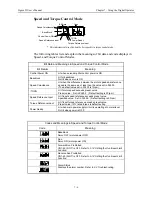
Sigma II User’s Manual
Chapter 6: Servo Adjustment
6 - 36
•
Torque Reference Filter Time Constant (Pn401)
If the mechanical system uses ball screws, torsional resonance may result. In
this case, the oscillation noise will be a high-pitched tone. The oscillation may
be minimized by increasing the time constant of the torque reference filter. Like
the integral time constant, this filter causes a delay in the operation of the servo
system. Therefore, this constant must not be set to an excessively large value.
•
Speed Reference Input Gain (Pn300)
Changing the speed reference input gain set in Pn300 is equivalent to changing
the position loop gain. In other words, an increase in the speed reference input
gain set in Pn300 is equivalent to a decrease in the position loop gain and vice
versa. Use this parameter in the following cases.
•
When the host controller does not have a function for adjusting the position
loop gain. (The host incorporates a D/A converter to change the number of
bits but cannot make fine adjustments of position loop gain.)
•
When it is necessary to clamp the full range of the speed reference output of
the host device to a specified rotation speed.
In normal operation, the default setting can be used as is.
Note:
If the servo amplifier is used for speed control, the position loop gain set in Pn102 is enabled in
zero–clamp mode only. In normal control operation, change the position loop gain through the host or
change the speed reference input gain in Pn300 in the servo amplifier. The position loop gain remains
the same if the setting in Pn102 is changed.
Adjustment Method
1.
Set the position loop gain to a low value in the host controller. Then increase the
speed loop gain set in Pn100 to within a range where there is no noise or oscilla-
tion. If the position loop gain cannot be changed through the host controller,
increase the speed reference input gain set in Pn300 to a larger value.
2.
Decrease the speed loop gain a little from the value set in step 1. Then increase
the position loop gain through the host controller to a range where there is no
noise or oscillation. Decrease the set value of Pn300 even if the position loop
gain cannot be changed through the host controller.
3.
Set the speed loop integral time constant in Pn101 while observing the position-
ing settling time and the vibration of the mechanical system. If the constant is
too large, positioning settling time will be long.
4.
Set the torque reference filter to a small value in Pn401 if the mechanical system
has no apparent shaft torsional resonance. If the mechanical system generates
oscillation noise in a high-pitched tone, shaft torsional resonance may be occur-
ring. In that case, set Pn401 to a larger value.
5.
Finally, progressively make fine adjustments to parameters such as the position
loop gain, speed loop gain, and integral time constant to find the optimal point.
Содержание SGMAH
Страница 1: ...Sigma II Series Servo System User s Manual...
Страница 2: ......
Страница 4: ...ii This page intentionally left blank...
Страница 6: ...iv This page intentionally left blank...
Страница 10: ...Sigma II User s Manual Table of Contents Preface viii Notes...
Страница 17: ...Sigma II User s Manual Table of Contents Preface xv C 6 Torque Control Mode C 9...
Страница 18: ...Sigma II User s Manual Table of Contents Preface xvi...
Страница 38: ...Sigma II User s Manual Chapter 2 Installation 2 10 NOTES...
Страница 472: ...Sigma II User s Manual Appendix C Examples of Standard Connections C 10 Notes...
Страница 487: ......
















































